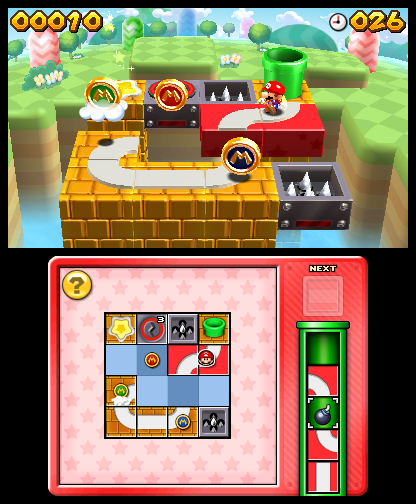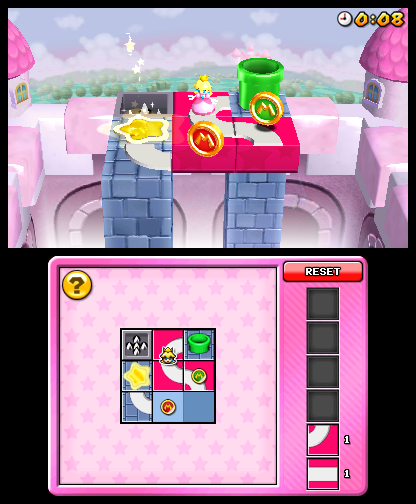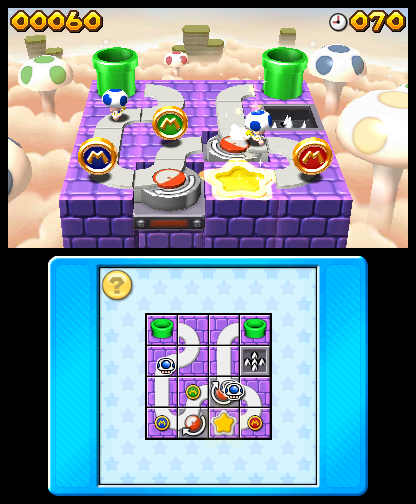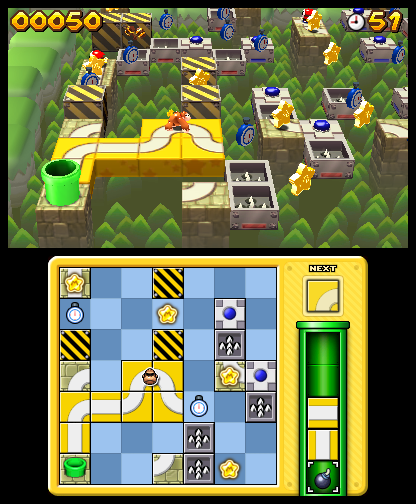 |
Title: Mario and Donkey Kong: Minis on the Move Publisher: Nintendo Developer: Nintendo Software Technology Release Date: May 9th, 2013 Genre: Puzzle/Platformer Platforms: Nintendo 3DS eShop Age Rating: E, Mild Fantasy Violence Official Website |
Gamers seem to have a wide variety of opinions about Nintendo these days, ranging from extremely negative to very positive. The naysayers have said the Big N is behind the times, with archaic graphics and outmoded concepts, while the loyal fans say Nintendo is better than ever and constantly improving. Regardless of your personal stance, there is one thing that Nintendo has been doing right and continues to do well to this day : They make great, simple yet complex games that are easy to learn but difficult to master. Such is the case in one of their latest eShop offerings, Mario and Donkey Kong : Minis on the Move, a great little game that exemplifies Nintendo’s strengths.
Minis on the Move, available now in the eShop for $9.99, is first and foremost a trend breaker in the Mario vs. Donkey Kong series. This is significant, since if I had known earlier how different this game was, I would have purchased it much sooner. Honestly, I was not a huge fan of the previous Mario vs. Donkey Kong series of games. While previous entries focused on simplistic Lemmings inspired 2D platforming, Minis on the Move literally breaks out into a new 3D-oriented style. This isn’t a mere artistic change either, as it brings a lot to the table and changes the gameplay for the better.
While the goal of the game is still to herd Mini Mario safely to the exit, the number of ways to do so in Minis on the Move is vastly improved. Now players have access to various pipe tiles which they can lay on the grid to guide Mario to the exit. If that were all you could do, I would not have been a fan, but luckily they expand upon this theme tremendously and deviously. First of all, there are a total of 4 main game modes available after you’ve gotten far enough in the first mode, Mario’s Main Event. The other 3 modes are Puzzle Palace, Many Mini Mayhem and the dreaded Giant Jungle (more on that last mode later). All 4 modes play slightly differently, while still incorporating the same essential gameplay mechanics of laying and manipulating tiles to progress.
Mario’s Main Event, represented by Mini Mario, has two key features that you need to grasp immediately. First is the Tile Pipe (not to be confused with pipe tiles). This is the reservoir from which you pluck various randomly generated tiles with your stylus to place them on the grid. The tricky thing about the Tile Pipe is that it can only hold a limited number of tiles, maxing out at 5, before it overflows and gives you a Game Over. So it’s important that you don’t just bide your time while playing. You really need to get the hang of thinking on your feet, since within about 20 seconds or so the Tile Pipe will be overflowing if you don’t move fast. The second key feature is the Exit Star that your Mini needs to reach to complete the level. Though this starts out simple enough, it quickly gets much more complicated to get from point A to point B.

Keep in mind that the elite player isn’t only concerning themselves with getting from point A to point B. The complicating factor in each level is the placement of 3 random “M” tokens in each stage. To get a perfect rank on a level, you not only need to reach the exit, you have to do so AFTER collecting all 3 tokens. This forces you to take circuitous routes through otherwise linear stages, all while being timed. Each stage ranges between 30 seconds to a minute and a half long, so you need to choose your path wisely and quickly. This feature hooked me rather quickly, and I found myself restarting levels if I got to the exit before collecting all the “M” tokens. Another simple thing that adds spice to the mix is the fact that, if a Mini reaches the end of an unconnected tile, you’ll have about 3 seconds to connect it before they fall to their deaths.
Another key facet of this mode is the use of Trash Cans and Magic Tiles. The Trash Can is a crazy useful item that lets you place extraneous or unusable tiles in it to dispose of them. What’s cool about this is that after you’ve disposed of 3 tiles this way, the game will gift you with a blue Magic Tile, which will automatically make a tile that changes its shape to connect two or more tiles. These aren’t quite as useful as they sound, since sometimes you need a Magic Tile to only connect in a certain way, and it will connect ANY way it deems necessary. This problem becomes more apparent when you are trying to make loops or a figure eight.
Now, you’re probably wondering why the hell you would spend your precious time, using randomly generated tiles, to make a figure eight. The reason is simple – Not only does this provide you with small timers that give you a +5 second boost to the clock per tile, giving you more time to complete the level, but it also creates an alternate exit tile. Put simply, some levels cannot be beaten without using this method. By forming either a closed circuit or a figure eight, you also get access to the all powerful Purple Tiles, which can be placed on top of existing tiles to form new paths.
Besides these, Mario’s Main Event also introduces you to the majority of tools you use in this and other modes, and there are tons. Besides what I’ve already mentioned, there are also Spring Tiles, Warp Pipes, Conveyor belts, Hammers, Road Blocks, Spike pits and Locked Exits. A few enemies will both hinder and help you as you progress through the game as well. There are Shy Guys, who you must Hammer to defeat, as well as Catapult Kongs, which fling you 2 tiles away from them in a certain direction, and Capture Kongs, the bane of Many Mini Mayhem mode. Speaking of which, let me discuss the other modes real quick.
The second mode you unlock is Puzzle Palace mode, represented by Mini Peach. While Mario’s Main Event is all about using randomly generated tiles to get to the Exit Star, Puzzle Palace mode is about using specific tiles in a particular order to get to the exit. I rather appreciated this mode, since I knew there was always a way to beat each level using the tiles provided, no matter how unfeasible it appeared. Personally, I felt this mode should have been the first to be available, instead of Mario’s Main Event, since that mode quickly got stressful and uncompromising. It was also nice not to have to worry about the Tile Pipe overflowing in Puzzle Palace mode, since it is all about strategy and using the right tiles in the right manner.

The third mode you unlock is Many Mini Mayhem, represented by Mini Toad. What is unique about this mode is that you have to manage multiple Minis at once, safely guiding all of them to the exit. Another feature unique to this mode is the ability to grab tiles on the grid and swap them around to form new paths on certain levels. You also don’t have to worry about placing tiles from the Tile Pipe onto the map in Many Mini Mayhem. Instead, you utilize Pivot Tiles, whose direction you can switch by tapping them, to primarily get about. What you do need to worry about in this mode is the notorious Capture Kong. This white-haired awful ape roams about the map, instantly kidnapping any hapless Toad that crosses his path, forcing you to find a hammer and pound him with a free Toad to succeed. This sounds much easier than it is, since you have to manipulate both your Mini’s path as well as that of the Kong, making sure he doesn’t catch up with all of your Minis, otherwise it’s Game Over.

The fourth and final mode is Giant Jungle, represented by Mini Donkey Kong. Whereas in all the previous modes the largest a stage could get is a 7×7 grid, Giant Jungle contains stages that are so large that you have to pan the camera around the stage just to see everything. Also complicating this mode is that, instead of the 3 “M” Tokens you need to get in previous modes to attain a perfect score, here you need to collect 10 Star Pieces arrayed all over each stage. This wouldn’t be so bad if the Tile Pipe didn’t also make a reappearance in this mode, a much more stressful feature here since the whole grid is so damned big, and it takes very little time for the Pipe to overflow while you’re looking around the stage to try and mark a trail. Further complicating this formula is the mind-boggling decision not to have Trash Cans in this mode. I often ended up being forced to place random tiles all over the map just to avoid being defeated by the Tile Pipe on more than one occasion. This struck me as a poorly designed expert mode overall, since Giant Jungle essentially has all the tricks and traps from the previous 3 modes, but on a much larger, more oppressive scale.

Besides these, there are also several completely optional Mini Games to be unlocked. These are the Mini Target Smash, Fly Guy Grab, Cube Crash, and Elevation Station. The first 3 all utilize a slingshot mechanic to achieve different goals, while the last one involves using a crank to elevate Mini Mario upward or downward to collect coins and avoid Bullet Bills. I personally found the Cube Crash and Elevation Station to be the most fun and unique of all 4 modes. All are relatively simple and pretty addictive to play, but they can get old after a while. Luckily, none of them are necessary to beating the actual game, but instead serve as welcome diversions when you’re stuck on a level in one of the main modes.


One other mode bears mention, and it is the Create and Share mode. Here, as you would expect, you can create your very own levels using all the tools found in Mario’s Main Event. You can place permanent tiles, “M” tokens, Entrance Pipes and Exit Stars, as well as the various traps and enemies. After doing so, you need to test your level before uploading it online, much like in Pushmo. Then, you can play the uploaded levels of others online and rate them according to how fun or challenging you found the experience.
Though more limited than the Pushmo level creator, this mode does offer the game a lot of replay value. There is also a strange mode called Toy Chest, where you can find unlocked Minis and polish the dirt off of them by using your stylus. Though this mode doesn’t seem to serve any functional gameplay purpose, it was fun to come back to it whenever I unlocked another Mini. Beyond that, you can also unlock Expert Levels by beating the first 60 or so levels in Mario’s main Event and Puzzle Palace. I didn’t find any extra levels for Many Mini Mayhem, however, and since I was unable to even beat the first Giant Jungle level thus far, I’m uncertain whether or not there are more to be unlocked beyond the initial 3 levels.
Sound effects in the game are simple and enjoyable, such as the mechanical key winding sound of a Mini rushing forward or the familiar tune whenever you grab a hammer. They all convey what’s happening and don’t distract from your concentration. I also found the hoots and hollers unique to each Mini as you hurried them on by tapping to be very entertaining. The music in the game is also pretty good, a compilation of new and old songs from various Mario games, such as classics like Super Mario Bros. 2, Super Mario 64 and more. Minis on the Move also incorporates sounds and music from previous entries in the Mario vs. Donkey Kong series, keeping the game tethered to the past while simultaneously expanding beyond it.
In terms of gameplay, everything is controlled by use of the stylus. As I previously noted, you can place tiles and switch Pivot Tiles direction by tapping them. Another nifty feature that starts out superfluous, but quickly becomes vital, is tapping your Mini to hurry them up. A simple tap will get them rushing for a few seconds, after which you must tap them again to keep them hurrying. The stylus can also be used to drop Tiles into the Tile Pipe and to drop bombs from the Tile Pipe onto the grid. Overall, I found the controls to be intuitive and satisfactory. The story is another matter.
Quite simply, Minis on the Move has absolutely no story. Granted, if you read the digital manual you can find out the bare bones explanation for why you’re playing the game, but that’s about it. No dramatic or comical events spur you on as you play, no villain threatens or impedes your progress, and for the most part I found myself fine with that. Previous Mario vs. Donkey Kong games tried too hard to force plot on us, an aspect of puzzle games that I generally find unnecessary. Minis on the Move focuses on gameplay over everything else, and that’s the way it should be.
I said earlier that Minis on the Move showcases Nintendo’s strengths of taking a simple core concept, efficiently getting us hooked and then enhancing that formula with devious twists and turns. All these are definitely accomplished in Minis on the Move, and for the most part I found myself absolutely loving this game. I ended up beating Mario’s Main Event, Puzzle Palace and Many Mini Mayhem’s initial 170 levels in approximately 20 hours. Granted, I was speeding through it so I would be able to review the game, but I doubt I would have bothered to play so fast had I not enjoyed the game in the process.
In the end, I only have 2 complaints about the game. First would be that the Tile Pipe is sometimes too random and churns out Tiles a bit too fast. The other complaint is about the Giant Jungle. Honestly, I just found that mode too difficult to be enjoyable. Granted, it’s not really necessary to beat it, but I found myself wanting to regardless, and was frustrated by my inability to do so. It definitely needed to be retooled slightly before the final game was released.
Overall I rather enjoyed Mario and Donkey Kong : Minis on the Move, and would heartily recommend it to any Nintendo or puzzle aficionado with a 3DS. It provides hours of brain-twisting fun, only slightly hampered by some unforgiving gameplay mechanics. I found it to be fully worth my $9.99, and I hope Nintendo has more quality downloadable games like it in store.
| Review Score | |
|---|---|
| Overall | |




